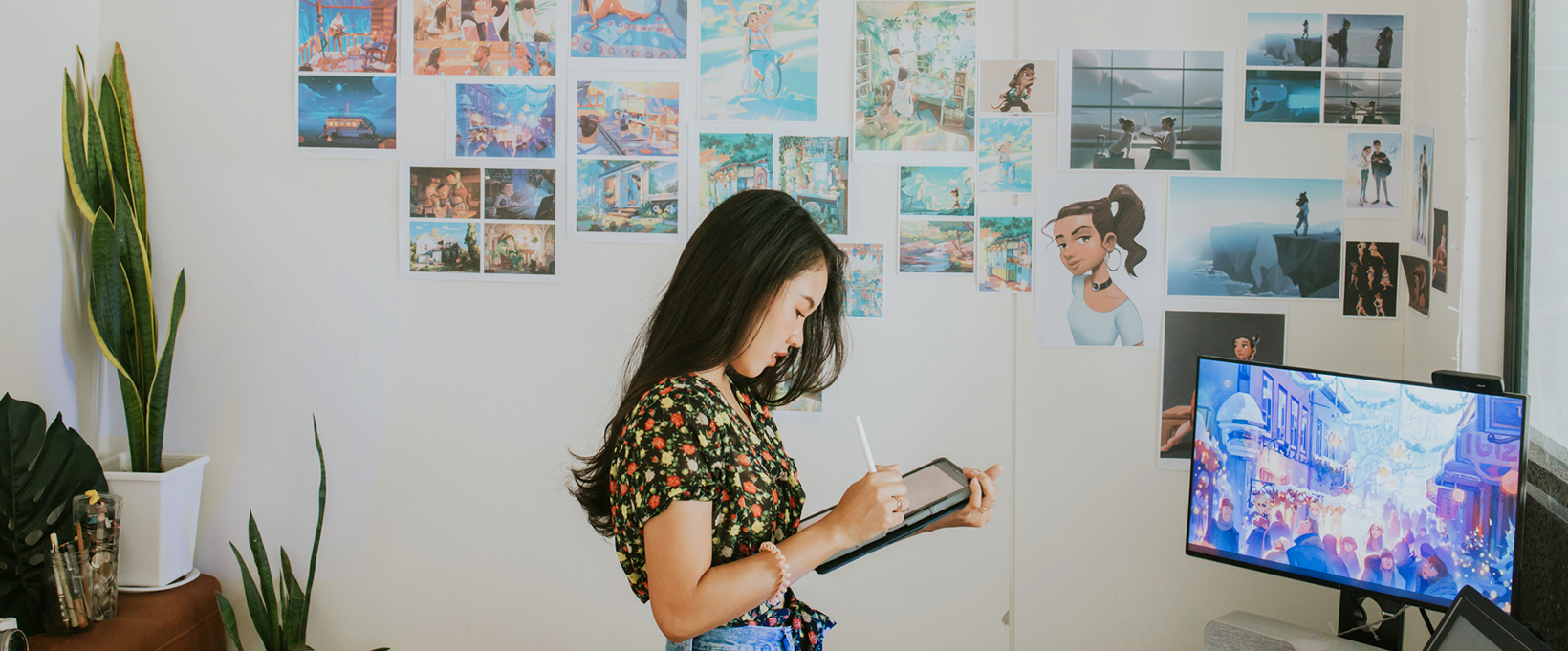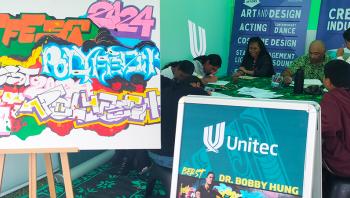Programme overview
The Bachelor of Design and Contemporary Art is the key to turning your creativity and innovation into an exciting career in the art and design industry.
With hands-on teaching and learning at the heart of this degree programme, you’ll gain a deeper understanding of your practice through making and creating while developing the technical skills and expert knowledge you’ll need to land your dream job.
Your first year of study will involve lots of discovery and experimentation. From there, you’ll build a specialist area of practice that draws inspiration from your unique creative abilities and lived experiences, while remaining ever-focused on learning through doing.
You’ll be supported every step of the way by a team of expert professionals. They’ll help you develop the knowledge and skills required to excel in the industry, motivate you to step outside your creative comfort zone, consider different cultural perspectives – and try something new.
Choosing your specialisation
In your second semester, you’ll choose an area of practice within one of our three specialisations– Visual Art and Design – and gain key skills and experiences in that area through studio projects, diverse technical workshops and in-depth contextual discussions.
Here are some of the areas of practice you can choose to focus on:
- Design: Graphic Design, User Experience (UX/UI), Product Design, Web Design
- Visual Arts: 2D/3D Practice, Photography/ Moving Image, Painting, Sculpture/Installation, Printmaking, Ceramics
- Digital media is on the horizon for the coming year, and in the meantime, the Design discipline seamlessly covers this field
Highlights
- Specialize in your chosen area of practice. Choose an area of interest from one of three majors: Visual Art or Design
- Gain key skills and experience through exciting studio projects, diverse technical workshops and in-depth contextual discussions.
- Apply practical learning in studios, computer labs, workshops, through one-on-one and group tutorials, wānanga and noho marae – with the opportunity to meet a wide range of artists and designers.
- Be creative in your own spaces. Our purpose-built gallery, exhibition and presentation facilities will prepare you for the professional environment.
- Get excellent student support from expert lecturers and technicians, ready to help you realise your creative ambitions.
- Work on a major creative capstone project in your final year of study – and exhibit this work at our end-of-year Gradfest. .
- Graduate work-ready for the future. This new qualification is a culmination of four years’ research – hundreds of hours of industry consultation, interviews and reflection, undertaken to ensure it meets the future needs of Auckland’s creative communities.
Develop the necessary skills to succeed
It’s our job to ensure that when you walk across that graduation platform, you’re prepared and work-ready. Meeting the demands of the art and design industry and carving a thriving career means developing the right skills – and that’s exactly what you’ll do in this degree programme:
- Expert knowledge. Gain the technical and conceptual knowledge to create specialist creative work in your chosen field.
- Communication. Effectively and professionally communicate with a range of stakeholders.
- Industry preparedness. Be ready for employment, self-employment and/or postgraduate study.
- Cultural diversity capability. Engage collaboratively with diverse teams and cultures in Aotearoa New Zealand and global cultural contexts.
- Critical engagement with ethically and socially responsible art and design practices.
Create your future in art and design
In Aotearoa New Zealand, design is the largest sub-sector in the creative industries, employing almost half of all creative professionals in the Auckland region. It has grown four times faster than the total Auckland economy. Aotearoa New Zealand is experiencing a growth period in art sales, and work produced by emerging practitioners is highly desirable. There is a dynamic range of cultural and commercial practice within the arts sector.
The skills that you’ll learn in this programme will not only provide a solid foundation but also help you excel in the world of art and design. As of 2021, it’s estimated that employment for designers in Aotearoa New Zealand will increase over the next five years, keeping career prospects for graduates high. In this degree, designers and artists are taught to be dexterous and adaptive to meet the needs of the dynamic industry.
By developing skills and experience in a specialised area, you can apply for more specialist roles, and as you continue to build your portfolio, you’ll be well set to take on more senior roles or contracting work.
Further study
Keen to push your creative boundaries even further? Then you might want to consider one of our postgraduate programmes: Postgraduate Certificate in Creative Practice, Postgraduate Diploma in Creative Practice and Master of Creative Practice programmes.
Admission requirements
What you will need to study this programme.
Domestic students
International students
Academic requirements
Applicants must be at least 16 years of age when they begin their studies and one of the following;
- Successful completion of an appropriate qualification at Level 4 or above in an art- or design-related subject, where appropriate or
- Should meet the country-specific admission requirement
And English entry requirements;
If English is not your first language, you will also need at least one of the following qualifications:
- An equivalent of IELTS (Academic) with minimum band scores of 6.0 with no band score lower than 5.5 or
- University Entrance Literacy: 8 credits at Level 2 or above in English or Māori (4 in Reading, 4 in Writing); or
- Evidence of English language proficiency as outlined in the NZQA Rules on the Unitec English Language Requirements for International Students Web-page.
Don’t meet these Academic requirements?
- If you don’t meet the academic criteria, our Bridging Education Programmes can help you qualify. Simply apply online, and we’ll discuss your next steps.
- If you don’t meet the above criteria, special or discretionary admission may apply; your eligibility will be determined at the interview.
Non-academic requirements
- When you apply for this programme, you’ll need to provide proof of your identity (ID) and other documents such as academic certificates – please have these handy when you’re ready to apply.
- As part of your application, you may also be asked to present a portfolio of work and/or attend an interview.
For more information, download the programme regulations (PDF 488 KB)
Courses and timetables
For more details on the courses including timetables, please click on the course names below.
| Courses | Credits | Aim |
|---|---|---|
| Studio 1 (DCAD5001) | 15.0 credits (0.125 EFTS) | This course enables students to develop foundational skills, knowledge, and experience in creative studio practice in art and design. |
| Studio 2 (DCAD5002) | 15.0 credits (0.125 EFTS) | This course enables students to further develop skills, knowledge, and experience in creative studio practice, drawing upon their interests and cultural backgrounds to generate art and/or design outcomes. |
| Practice in Context 1 (DCAD5101) | 15.0 credits (0.125 EFTS) | This course equips students with the academic skills needed for tertiary study in art and design, including the ability to undertake independent creative research and an understanding of key concepts from Te Ao Maori. |
| Drawing and Ideation (DCAD5201) | 15.0 credits (0.125 EFTS) | This course develops technical skills fundamental to drawing and ideation practice, including media, surface, application, scale and colour in 2D and 3D tactile approaches. |
| Reproduction and Multiple (DCAD5202) | 15.0 credits (0.125 EFTS) | This course develops technical skills fundamental to modes of reproduction, serial and multiplicity, including digital and tactile approaches to print, photographic, mold making, and laser etch. |
| Digital Technologies (DCAD5203) | 15.0 credits (0.125 EFTS) | This course develops technical skills fundamental to creative digital technologies through the Adobe Creative suite. |
| Design for Screens (DCAD5301) | 15.0 credits (0.125 EFTS) | This course develops fundamental technical skills and processes for the research and design of screen-based information systems and interfaces. |
| Experimental Drawing (DCAD5401) | 15.0 credits (0.125 EFTS) | This course develops experimental skills in digital and tactile technologies in 2D, 3D and lens-based practice. |




